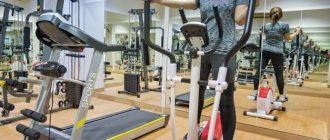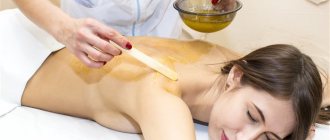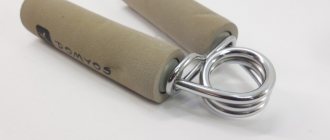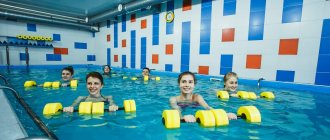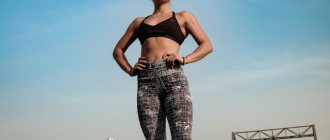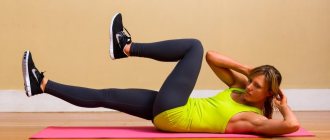By design, an inversion table is a board with an adjustable angle of inclination, lying on which a person can easily and safely change the natural position of his body to an “unnatural” one, i.e. hangs upside down. This condition is called complete inversion and is believed to have beneficial effects on the body. This is useful for spinal stretching and relaxation. In this guide, we will look at who might benefit from an inversion table, how to use it to reduce back pain, and how to exercise correctly. You will find out whether buying the best inversion table for back pain will be justified by the result, what doctors say about it and we will compile the Top 5 best inversion tables in terms of equipment and price.
What is an inversion table and what is it for?
The table is a stable structure made of metal or plastic in the form of a flat bench (table top) with leg clamps and two handles; there are both mechanical and electromagnetic exercise machines. The essence of the table is to change the angle of the body, up to a vertical position (upside down). When the position of the body in space changes, the spine lengthens due to stretching of the intervertebral discs. The inversion therapy method provides relief from pinched nerve endings and treatment of spinal diseases (protrusions, hernias, pain associated with displacement of the vertebrae and changes in posture).
When training on a gravity table, it is important not to just hang upside down at a comfortable angle, but to perform various techniques, including slight bending and twisting to stretch not only the vertebrae, but also the muscles.
Gymnastics has a positive effect if, at the initial stage of training, the technique is observed by a specialist in the field of physiology, a neurologist, a chiropractor, and so on. You should not start the exercise on your own ; especially if spinal diseases worsen, you should consult a doctor.
Before considering the benefits and harms of an inversion table, let’s study a little about the effects of traction on the spine and their feasibility.
- What happens when you stretch for a long time? Intervertebral discs are subject to tension, which increases the risk of injury to the capsule of the intervertebral joints. That is, by stretching the spine, trying to alleviate the syndromes of some diseases, you can get new problems.
- Does traction solve spine problems? Let's look at the example of a rubber band. Use force to stretch the rubber on the sides - it will lengthen, weakening the impact - the tape will return to its original position. The same is true with the spine, the problem does not go away after returning to its natural position; if a disc in any department was bulging before, it will remain so; if a muscle was pinched (or nerve endings), it will remain in the same place and get pinched again. Therefore, temporary symptom relief is not the solution.
- Does an inversion table solve the problem? By stretching and simultaneously strengthening the muscles that hold the spine (stabilizers), a therapeutic effect can be achieved. If the muscles are weak, they will not be able to hold the vertebrae in a stable position after traction, and strengthening them will serve as a kind of corset to maintain the normal position of the vertebrae between the joints, reducing negative factors.
How does an inversion trainer work?
Fans of inversion therapy point to the antiquity of this healing technique, which was allegedly used by Hippocrates 2500 years ago. However, real interest in inversion arose only at the end of the 20th century. Gymnast Christopher Harrison came up with anti-gravity yoga - exercises on “hammocks” suspended from the ceiling. Gravity boots, designed for hanging upside down, which were used by the hero of the movie “American Gigolo,” came into fashion.
At the same time, in the 1980s, active research began on the effect of procedures on patients with certain diseases. Proponents of the inversion technique attributed to it broad healing properties: increased growth, treatment of varicose veins, improvement of cerebral circulation and lymph flow.
Of course, the wider the list of indications, the more doubts arise about the effectiveness of the device, because one tablet cannot treat everything. The test results did not really convince the skeptics. But there was evidence of side effects: blurred vision, retinal detachment, headaches, increased blood pressure.
So far, researchers have proven for certain the benefits of an inversion table only for treating the back.
Scientific research and proven effectiveness
Patients with lumbosacral sciatica have been able to avoid surgery thanks to a combination of physiotherapy and inversion techniques, according to an article by doctors from James Cook University Hospital, Middlesbrough. The researchers divided patients awaiting surgery into two groups: the first group (13 people) was prescribed physical therapy and an inversion machine, and the second group (11 people) received only physical therapy.
After 6 weeks, it turned out that the majority of patients from the first group (10 out of 13) no longer required surgical intervention, because their condition has improved significantly. The results of the examination of the second group were not so impressive: out of 11 people, only two did not fall under the surgeons’ scalpel.
Another study examined the effects of an inversion trainer on patients with chronic low back pain. Participants in the experiment used an inversion table at different angles for 8 weeks. The best results were found in the group that used the machine at an angle of 60 degrees: in these patients, the elasticity of the lumbar region increased, pain and discomfort disappeared.
It is believed that the inverted position of the body takes the load off the spine, which suffers from the force of gravity and our evolutionary “habit” to walking upright. The pressure on the intervertebral discs decreases, and the space between the vertebrae increases. As a result, lower back pain disappears.
The question remains for how long. Skeptics believe that inversion tables do not cure, but relieve unpleasant symptoms. The exercise machine stretches the paravertebral muscles and ligaments, temporarily relieving muscle spasm, says expert Celeste Robb-Nicholson, MD Editor in Chief, Harvard Women's Health Watch. According to the doctor, the merits of inversion therapy in improving health have not been proven, moreover, it has many contraindications (eye diseases, hypertension, heart disease, pregnancy). However, exercises on an inversion table can still be recommended for the comprehensive treatment of back pain under the supervision of a physiotherapist.
If we summarize the words of experts, it becomes clear that stretching on an inversion table will not cure the disease, but it can relieve symptoms and, therefore, reduce the use of painkillers.
Disadvantages of exercising on an inversion table
- It is not the only way to solve problems associated with spinal diseases.
- It gives only a temporary effect that does not last without exercise.
- Allows you to perform a limited number of exercises that do not fully affect all important stabilizer muscles.
- It can aggravate the problem; if you use the exercise machine incorrectly, there is a risk of getting new injuries.
- It has a large list of restrictions and contraindications.
Basic exercises performed on an inversion table
- Balancing - you need to try to keep the back in a horizontal position.
- Rotations around an axis. One arm is positioned along the body, the other is raised above the head, and chalk rotations of the table are performed. 10 - 15 times in both directions.
- Inversion - arms are placed above the head, the table takes a vertical position. That is, hanging upside down is performed. It is recommended to start with incomplete inversions and gradually reach a complete inversion.
Top 3 manufacturers of inversion tables
Inversion table HyperFit HealthStimul 30MA
Model M25Model M30
Home portable inversion table HyperFit HealthStimul 30MA can withstand enormous loads. A user weighing up to 200 kg can exercise on the machine. The inversion of the table is 180 degrees, there are 5 tilt angles, height adjustment, and an improved ankle locking system. For maximum user comfort, a vibration massage option is provided, as well as heated massage pillows. The pillows can be removed and used for relaxation. The model comes complete with a control panel, which is used to set the settings. Prices for an inversion table range from 32,000 to 34,000 rubles.
Inversion table OPTIFIT
Home budget exercise machines with soft, comfortable bolsters and clamps, can withstand user weight up to 136 kg, and are mechanically fixed in three positions. There are models with massagers. The cost varies from 11,800 to 14,500 rubles.
DFC inversion table
A brand of home exercise equipment, including inversion tables, offering a huge selection of exercise equipment of various characteristics and a wide range of prices. Exercise machines with a folding design can withstand user weight from 110 to 150 kg, depending on the model and cost, and are adjustable in several positions: 40, 60, 90, 180%. There is a model with a massager and remote control (price about 24,000 rubles). Prices for all models vary from 10,400 to 50,000 rubles.
Inversion table Z-UP
A more expensive nonsense, representing a wide range of professional high-quality electric inversion tables. The simulators can withstand load weights from 120 to 136 kg. Folding design, the exercise equipment runs on electricity and is controlled by just two buttons. In the event of a power outage, the table returns to its original position automatically. The cost of products ranges from 100,000 to 200,000 rubles.
Moon boots.
Let me start with this. I used to have back pain and inflammation of the sciatic nerve. Anyone who has experienced this knows this feeling. I know how inconvenient this can be and how it can ruin life.
After I graduated from college, I opened a landscaping and landscaping company. I worked hard because I wanted financial independence. I really tried my best. Sometimes I had to accept orders for work without even knowing how to do such work.
Once, for example, a client approached me who wanted to build a stone wall without cement on his property. I said: “No problem!” But since the wall would have to bear a lot of load, I asked if I could put cement at the base of the wall. The client agreed.
On the first day, I dug a hole, went to the store and bought cement. When I returned, I decided to load two 60 kg bags of cement on my shoulders to save time walking up and down. I put the first bag on my shoulder, and when I bent down and turned a little to pick up the second, I heard a not very pleasant sound - the crunching of my own back. In an instant I was lying on the ground in pain. I spent the following weeks either in bed or sitting in front of the TV.
About halfway through the second week, a friend of mine who visited me told me that a new-fangled back treatment device called “moon boots” had just come out. He received a couple of these for New Years. I borrowed them from him. My dad installed a horizontal bar in the apartment so I could hang upside down. I started doing this for 5-10 minutes a day, every day.
Soon my back felt much better, my spine was straightened, my muscles became toned. My posture has noticeably improved, which, by the way, was not bad before. I continued to use upside down hangs and moon boots on a regular basis, not only for my healing, but as a way to experiment with different exercises that could lead to higher levels of fitness. Thanks to the inversion method, there are fewer injuries at work, and the body feels great. This is cool!
Passive correction
Objects used for passive correction can be called relatively physiological - they seem to partially adapt to the human body and gently correct it to the desired state. This includes, in particular, orthopedic furniture - this can be office chairs, car seats, etc. If they help fix the natural, physiological position of the body, that’s good.
A high-quality orthopedic mattress can also provide a powerful healing effect - there are many such examples. Even in such complex cases as compression fractures of the vertebrae (here, in particular, products have proven themselves well). A person spends almost a third of his life sleeping, and if during this time the spine is in a favorable condition, this in itself becomes a “silent” treatment and prevention.
Preventative massager Master Spin
Master Spin
prophylactic is good to use for correcting the spine, especially the thoracic region.
We all have congenital normal physiological thoracic kyphosis, that is, some curvature of the thoracic region. Most often, it increases with age due to stress, physical and psycho-emotional stress, so sometimes you want to slightly bend it back. Master Spin helps very well in this regard - both sitting and especially lying down.
Sometimes it is worth correcting the lumbar spine - in cases where the lumbar lordosis is smoothed - and, as it were, simulating a little of this lordosis with the help of a prophylactic. Master Spin has three positions: slight, medium and steepest bend. It’s worth starting with the minimum – and then, if necessary, adding.
Further, it matters: whether the legs are bent at the knees or not, and the arms lie along the body - or extended behind the head. The more aligned the legs are and the arms are extended behind the head, the more the spine will stretch and bend - and you need to be careful with this. In the photo below, the girl lying on the prophylactic keeps her legs bent, and this is more physiological; if she straightens them and lowers them, the deflection of the lumbar spine will increase. This must be done carefully, listening to your body, so as not to “break the woods” - this is the time.
Secondly, exposure matters: how long to stay on the prophylactic. Not for too long, because you can “overdo it” and then have a problem. It’s better to lie down for about a minute, and if the spine is stiff, then start little by little - for example, 10-20 seconds - then get up, walk around, try to feel: is it enough or not enough? Gradually, in separate approaches. If it’s not enough, add it; if you feel that it’s already good, it’s better to come next time in half an hour or an hour.
After all, the body has inertia: if you have done something to it, it can still “reach” the state that was “designed” for it for half an hour or an hour. Truly sensitive people may know when enough is enough, but there is always a risk of overdose. Therefore, it is better to underdo it than to overdo it - that’s for sure.
Indications and contraindications
The use of an inversion trainer is effective for pain in the back muscles, pinched nerves, spinal hernias, and spasms of the torso muscles. Exercises are also indicated for various postural disorders, weakness of the ligamentous apparatus of the spinal motion segments, varicose veins of the lower extremities and pelvic organs.
The inversion table has the following contraindications:
- tendency to increase intraocular pressure;
- stage II hypertension;
- various heart rhythm disturbances;
- the presence of aneurysm of cerebral vessels;
- osteoporosis;
- sclerotic changes in the vessels of the brain;
- ischemic heart damage (acute period);
- chronic pathologies of connective tissue;
- displacement of internal organs under the skin;
- presence of prosthetic joints;
- taking anticoagulant drugs;
- obesity;
- senile dementia.
Also, the exercise machine should not be used by women during the entire period of pregnancy.
Self-stretching
When working with such simulators, much depends on a person’s ability to clearly coordinate individual muscle groups - to tense some in time and relax others. After all, it is the relaxed areas of the body that stretch well.
Teeter Hang Ups P3 Back Stretcher
The Teeter Hang Ups P3 (PDF) is a really good design, portable when folded and quite effective for its intended purpose. Acts directly on the lumbar and lower thoracic spine. The upper thoracic is involved to a lesser extent, partially and indirectly, only when the lower thoracic is effectively stretched. The legs are well stretched - shins, knees, thighs, hip joints and pelvic structures. This is important because they also tend to shrink.
75 percent of all disability cases are orthopedics. That is, these are problems of the spine and joints. First of all – knees and hip joints. And such a simulator allows you to actively stretch and stretch your legs and lower two-thirds of your body at home. Not bad prevention at all, and in many cases – effective treatment.
When working with this machine, you should only tense your shoulder girdle and triceps. The rest should be relaxed. Otherwise, you will “slip” in place: when your whole body is tense, you won’t be able to stretch anything.
Among user reviews, there are occasional complaints that only the knees and feet are strained, but not the spine. This means that there are hard blocks in the pelvis, lower back or spine that need to be removed using osteopathic methods and thus wedging the entire body. If this is not done, then with his effort a person can injure those structures that stretch much more easily than others.
The disadvantages of this machine compared to an inversion table: there is no vertical position that stretches naturally - this is one, and secondly, there is no lifting of the insides, which occurs when hanging upside down. However, hypothetically, you can try to lie down on an inclined plane with it. In this case, precautions for inversion therapy should be taken into account.
Teeter P2 Back Stretcher
Teeter P2 (PDF) is a “shortened” version of the previous device. Its action is designed only for the spine. However, it is less effective than the Teeter Hang Ups P3, despite the variety of applications (see photo below).
However, this is also a stretch, which means it’s better than nothing.
Additional safety tips.
The benefits of the inversion method have been proven. Still, if you have the opportunity to use an inversion table at first, then use it rather than inversion boots. It is better to start hanging slowly, at a slight angle for a short amount of time. Going straight into a full inversion for an extended period of time can cause harm and subsequent pain.
It is important to remember that inversion causes blood flow to the upper body and may be contraindicated if you have heart, spine or eye problems. Talk to your doctor before you start exercising.
Monitor your health and be patient. The inversion table and gravity boots are great devices that can be used by you for a variety of purposes and can be used on a daily basis. Make training with inversion machines a habit and your body will reap the benefits of your efforts. Good luck!
This is the post, friends! Thanks again to Dmitry for your efforts! I personally liked the post.
Now you know what the inversion method can give you and how hanging upside down can help you grow. I wish you success in your training!
Best regards, Vadim Dmitriev
Disadvantages of the simulator
You should remember the disadvantages of an inversion table:
- a limited list of exercises does not allow you to properly work out the stabilizer muscles. A sustainable positive effect is possible only with an integrated approach;
- Illiterate use of the table can cause aggravation of existing back problems.
Adaptation of the body and vestibular apparatus should be gradual, in particular, the maximum angle of additional inclination per lesson should not exceed 5 degrees. Moreover, you can increase the angle every 2-3 days.

